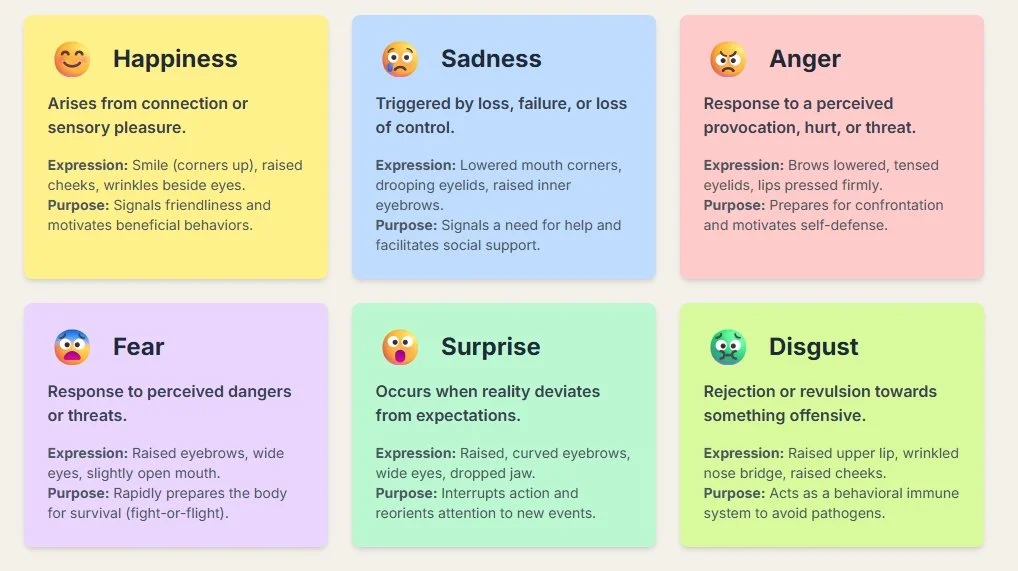An Overview of The Universal Emotions
Part Two in our Guide to Paul Ekman's Universal Emotions
Paul Ekman's research identified a set of universal emotions, each characterized by distinct psychological features, typical facial expressions, physiological responses, and an evolutionary purpose. While the core expressions are considered universal, their outward display is often mediated by cultural norms known as display rules.
EXPLORE THE UNIVERSAL EMOTIONS
Learn to identify universal emotions by building faces, or test your skills in a challenge.
Key Features
Challenge Mode
Which emotion is this?
Your Badges of Mastery:
Happiness (Enjoyment)
Happiness, often referred to as enjoyment, is widely regarded as the most desirable of the universal emotions, typically arising from feelings of connection or sensory pleasure. It encompasses a broad spectrum of pleasurable states, ranging from profound peace to intense ecstasy. Psychologically, happiness is associated with reward pathways in the brain and serves as a powerful motivator for behaviors that lead to positive outcomes and overall well-being.
The universal facial expression for happiness is the smile. A genuine smile, known as a Duchenne smile, is distinguished by the involuntary contraction of muscles around the eyes, creating characteristic "crows feet" wrinkles, in addition to the upward pull of the mouth corners. In contrast, a polite or "social" smile typically involves only the mouth muscles, lacking the authentic eye involvement. Physiologically, individuals experiencing happiness commonly report sensations of feeling light or uplifted, energetic, a buzzing or tingling sensation, warmth, or a sense of being grounded. While the specific physiological markers for happiness are less extensively detailed than for negative emotions, it is understood that general emotional states involve neurophysiological changes and distinct patterns of physiological activity. The evolutionary purpose of expressing enjoyment is multifaceted: it functions as a social signal of friendliness and non-threat, fostering positive social interactions. It also motivates behaviors crucial for individual and species survival, such as reproduction and child-rearing. Furthermore, happiness can enhance memory, reinforcing successful behaviors for future adaptive responses. Despite the universality of the underlying facial patterns, cultural "display rules" significantly influence how and when happiness is overtly expressed. These rules dictate the acceptable intensity and frequency of emotional displays within a given social context, meaning that while the internal experience and basic expression are universal, their public manifestation can vary.
Sadness
Sadness is a fundamental and often unpleasant emotion deeply woven into the fabric of human experience. It is typically triggered by significant events such as loss, the failure to achieve a cherished goal, or a perceived loss of control. This emotion is associated with punishment pathways in the brain and can manifest as either a short-lived feeling or a more prolonged state, such as grief.
The universal facial expression for sadness is characterized by a distinctive set of muscular movements. These often include the lowering of the mouth corners into a frown, a drooping of the eyelids, and, notably, the raising of the inner portion of the eyebrows while the outer corners remain slanted downwards. Watery eyes or the presence of tears are also common physiological accompaniments to sadness. Physiological responses to sadness can show variability across studies; some research indicates an acceleration of heart rate or an increase in skin conductance levels (SCL), while other studies report decreases in these measures. However, studies on loss-evoked sadness have shown specific patterns, such as an increase in diastolic blood pressure and a longer time for skin conductance levels to return to baseline compared to sadness induced by failure. From an evolutionary perspective, sadness is thought to play a crucial role in social communication by conveying an individual's internal state and signaling a need for help or comfort from others, thereby facilitating social support networks. Similar to other emotions, cultural display rules significantly influence the acceptable types and frequencies of emotional expression, including sadness. For instance, societal norms may dictate that individuals suppress public displays of sadness to strangers, or that men refrain from showing tears in public. The interpretation of sadness, like other emotions, is always filtered through an individual's familiar cultural standards.
Anger
Anger is an intense and often uncomfortable emotional state, typically arising as a non-cooperative response to a perceived provocation, hurt, or threat. Psychologists generally consider anger a normal, natural, and mature human emotion that possesses functional value for individual survival and mutual cooperation within social groups. When appropriately channeled, anger can mobilize psychological resources, boosting determination to correct perceived injustices or promote social fairness.
The universal facial expression for anger is characterized by specific muscular actions. The eyebrows are pulled down and drawn together by the corrugator muscles, often accompanied by a tensing or tightening of the lower eyelids. The lips are typically pressed firmly together or slightly parted in a squared shape, and the nostrils may flare while the jaw clenches. This combination of facial movements creates a glaring, fierce expression. Physiologically, anger commonly triggers a range of physical effects, including an increased heart rate, elevated blood pressure, and heightened levels of stress hormones such as adrenaline and noradrenaline. It is widely considered a key component of the "fight-or-flight" response, preparing the body for confrontation. An increase in blood flow to the arms and hands is also a notable physiological change associated with anger. From an evolutionary standpoint, anger has deep roots in our evolutionary history and is likely genetically coded, preparing individuals to confront obstacles and motivating self-defense or assertiveness. The specific facial actions, such as furrowing the brow and tensing the eyelids, serve to fixate attention on a potential target of attack and sharpen visual focus. Anger also serves crucial interpersonal functions, acting as a signal of caution or indicating the potential initiation of conflict to others. Despite these universal expressions, cultures often endorse modifications of angry displays through established "display rules." These rules can dictate, for example, that anger be suppressed in public settings or that women refrain from exhibiting anger openly. Such cultural influences can, in turn, affect the accuracy with which anger is recognized across different groups.
Fear
Fear is an unpleasant and potent emotion that arises in response to perceived dangers or threats, whether they are immediately present or anticipated in the future. This emotion is intimately linked to anxiety and is subject to modulation by both cognitive processes and learning experiences. It is associated with stress pathways and often accompanies feelings of uncertainty.
The Western stereotypical facial manifestation of fear is characterized by a wide-eyed, gasping expression. Typical facial expressions include eyebrows that are raised, often pushed together without forming arches, widened eyes that expose the white sclera above and sometimes below the iris, and a slightly open mouth with tensed or stretched lips. Wrinkles may also appear between the eyebrows. Physiologically, fear triggers a cascade of changes as part of the "fight-or-flight" response. These include an accelerated breathing rate (hyperventilation), an increased heart rate, vasoconstriction of peripheral blood vessels, dilated pupils, and heightened muscle tension. In extreme cases, fear can induce an immobilized "freeze" response. Individuals experiencing fear may also report sensations such as dizziness, lightheadedness, a feeling of being choked, sweating, shortness of breath, nausea, or shaking. Evolutionarily, fear is considered a primal emotion, having evolved to enable organisms to rapidly mobilize internal resources to enhance survival in the presence of threat. It facilitates adaptive responses to environmental challenges, allowing individuals to react quickly to potential dangers. The wide-eyed expression, in particular, is hypothesized to serve a functional purpose by enhancing sensation, expanding the visual field, and speeding eye movements toward potential threats. Despite its proposed universality, cross-cultural research indicates that the stereotypical fearful face is often recognized less accurately than other emotions, particularly in non-Western and remote populations. For instance, a study among the Trobrianders of Papua New Guinea found that the classic posed fear face, characterized by a gasp, was consistently interpreted as conveying threat or aggression rather than fear. This suggests that while the biological underpinnings exist, the interpretation and experience of fear can be shaped by social relations and cultural contexts, influencing when and how fear is manifested and understood.
Surprise
Surprise is an emotion that arises when reality deviates from expectations or assumptions, representing a discernible gap between what is anticipated and what actually occurs. Its intensity can vary significantly, from a mild, fleeting reaction to a profound experience that might even trigger a fight-or-flight response. Paul Ekman, along with Carroll Izard, includes surprise as a primary or basic emotion in their taxonomies, underscoring its fundamental role in human affect. As an emotion, surprise typically lasts only until the unexpected trigger has been processed and understood.
The universal facial expression of surprise is characterized by several distinct features: eyebrows are raised high and curved, creating horizontal wrinkles across the forehead. The eyes are wide open, with the upper eyelid elevated and the lower lid relaxed, often exposing the white sclera both above and below the iris. Additionally, the jaw typically drops open slightly, resulting in a mouth-agape appearance. Pupil dilation (mydriasis) or constriction (miosis) may also occur, with dilation potentially indicating positive valence and constriction negative valence. The physiological response associated with surprise falls under the category of the "startle response," which is remarkably fast, occurring in less than two-tenths of a second. Evolutionarily, the primary function of surprise is to interrupt ongoing actions and reorient attention rapidly toward a new, potentially significant event. This reorientation can be crucial for survival, as it allows individuals to quickly assess and react to novel or threatening stimuli. Furthermore, surprise can serve an epistemic function, making individuals aware of their own ignorance or flawed assumptions, thereby opening a pathway to new knowledge and learning. While the core expression is universal, interaction variables such as social and cultural norms can influence the manifestation and interpretation of surprise. Some research indicates a less direct link between the overt facial display of surprise and the subjective experience of the emotion, suggesting variations in how surprise is expressed.
Disgust
Disgust is a powerful emotional response characterized by rejection or revulsion towards something perceived as potentially contagious, offensive, distasteful, or unpleasant. While primarily associated with the sense of taste, it can extend to sensory experiences involving smell, touch, or vision. Paul Rozin has extensively studied disgust, and it is recognized as one of Robert Plutchik's basic emotions, featuring a characteristic facial expression that Ekman identified as universal.
The typical facial expression of disgust involves a distinctive set of movements: the upper lip is raised, the nose bridge wrinkles, and the cheeks are drawn upwards. The brows may also be slightly narrowed. Physiologically, disgust presents a unique profile compared to fear, anger, and sadness. It is associated with a decrease in heart rate, particularly for "body-envelope violations," and can induce proto-nausea in the stomach, especially for bodily effluvia. Other physiological responses may include reduced blood pressure, lowered heart rate, decreased skin conductance, and alterations in respiratory behavior. Notably, women tend to experience disgust more prominently than men. The evolutionary purpose of disgust is strongly linked to protection from infection and disease avoidance. It is believed to have evolved as a "behavioral immune system," serving as a first line of defense against harmful substances or pathogens, such as rotting food, vomit, or dead bodies. The recognition of disgust in others, for instance, seeing a conspecific react with disgust to a food, allows individuals to infer that the food is bad and should be avoided, highlighting its significance for collective survival. The facial expression of disgust is readily recognizable across cultures. However, cultural differences exist in what specifically elicits disgust; for example, Americans may associate disgust with actions that limit individual rights, while Japanese individuals might link it to actions that disrupt social integration.
(Sometimes) Contempt
Contempt is an emotion defined as a feeling of dislike for and superiority (often moral) over another person, group, or their actions. It stems from a judgment that the target of contempt has failed to meet an important interpersonal standard, which the person experiencing contempt deems significant. Contempt can manifest as a highly visceral emotion, akin to disgust, or as a more detached, cool disregard. A notable aspect of contempt is the "positive self-feeling" experienced by the contemptuous individual, reflecting a sense of elevated status or moral standing.
Contempt is unique among the universal emotions for having a unilateral, or asymmetrical, facial expression. This expression is characterized by the tightening and slight raising of the lip corner on one side of the face, often creating a smirk or pulling towards the eye or ear. This unilateral action is primarily triggered by the dimpler muscle (zygomaticus major), most commonly on the left side. The expression may or may not be accompanied by a hint of a smile or anger. Other associated nonverbal signals can include eye-rolling, a dismissive gaze, certain thumb gestures, or a haughty head flick. Physiologically, contempt is the least extensively researched of Ekman's universal emotions. Unlike disgust, which typically prompts a physical aversion and desire to move away, contempt does not necessarily involve a wish to remove oneself from the situation. The sensations associated with feeling contempt are not inherently unpleasant; in fact, they may even feel positive for some, as the emotion asserts a sense of power or superiority. It can, at times, be accompanied by sensations similar to mild anger, such as tension or heat. Research also suggests a correlation between dispositional contempt and cardiovascular disease in those who experience it. The primary function of contempt is widely understood to signal superiority, disengagement, and disdain, thereby asserting power or status. It can play a role in moral communities by demonstrating that certain actions are unethical and, in a social sense, removing them from the moral community. Ekman initially did not include contempt in his original list of universal emotions but added it following continued cross-cultural research. Studies have shown that the contempt expression can be identified across Western and non-Western cultures. However, scientific findings on its universality are considered "less clear" or even "highly questionable" compared to the other six, and it was not consistently studied as a distinct emotion in many early investigations. Despite this, cultural display rules, which govern when and how emotions are shown, also apply to contempt.
Explore Universal Emotions
Ready to discover Paul Ekman’s research on the seven universal emotions and how we express them?
Universal Emotions Summary
| Emotion | Definition/Psychological Characteristics | Typical Facial Expressions (Key Indicators) | Key Physiological Responses | Evolutionary Purpose | Cultural Display Rules |
|---|---|---|---|---|---|
| Happiness | Desirable, arises from connection/pleasure, ranges from peace to ecstasy, associated with reward. | Smile (corners pulled back & up), raised cheeks, wrinkles beside eyes ("crows feet" for Duchenne smile). | Feeling light/uplifted, energetic, buzzing/tingling, warm, grounded. | Signals friendliness, non-threat; motivates beneficial behaviors (reproduction, child-rearing); enhances memory. | Influences when and how intensely happiness is displayed publicly. |
| Sadness | Unpleasant, triggered by loss, failure, or loss of control; associated with punishment. | Lowered mouth corners, drooping eyelids, raised inner eyebrows (outer corners slanted down), tears/watery eyes. | Variable (increased/decreased HR/SCL); loss-evoked sadness linked to increased DBP, longer SCL restoration. | Signals need for help/comfort; facilitates social support. | Influences acceptable public display (e.g., suppressing tears, avoiding showing to strangers). |
| Anger | Intense, uncomfortable, non-cooperative response to perceived provocation/threat; functional for survival. | Brows lowered & drawn together, tensed lower eyelids, lips pressed firmly/squared, nostrils flare, jaw clenches. | Increased heart rate, elevated blood pressure, increased adrenaline/noradrenaline, increased blood flow to arms/hands. | Prepares for confrontation; motivates self-defense/assertiveness; fixes attention on target; signals caution/conflict. | Influences management of angry expressions (e.g., suppression in public). |
| Fear | Unpleasant response to perceived dangers/threats; linked to anxiety, uncertainty. | Raised eyebrows (pushed together, no arches), wide-open eyes (upper white sclera showing), slightly open mouth, tensed/stretched lips. | Accelerated breathing, increased heart rate, vasoconstriction, dilated pupils, increased muscle tension; dizziness, sweating, nausea. | Rapid preparation for survival; facilitates quick reaction to dangers; enhances sensation/visual field. | Recognition can vary cross-culturally; shaped by social/cultural context of threat. |
| Surprise | Occurs when reality deviates from expectations; ranges in intensity. | Raised, curved eyebrows; horizontal forehead wrinkles; wide-open eyes (upper lid elevated, lower lid down); dropped jaw (mouth agape). | Startle response (very fast); pupil dilation (positive valence) or constriction (negative valence). | Interrupts action, reorients attention to new events; reveals ignorance, opens path to new knowledge. | Influenced by social/cultural norms; variations in facial display possible. |
| Disgust | Rejection/revulsion to something contagious/offensive; primarily taste-related. | Raised upper lip, wrinkled nose bridge, raised cheeks, slightly narrowed brows. | Decreased heart rate, proto-nausea, reduced blood pressure, decreased skin conductance. | Behavioral immune system; avoids disease-carrying pathogens; signals bad food to others. | Universally recognizable, but cultural differences in elicitors. |
| Contempt | Dislike and superiority (often moral) over another; judgment of failed standards. | Unilateral lip corner tightening/raising (smirk); eye-rolling, dismissive gaze, certain thumb gestures. | Not consistently researched; not necessarily unpleasant sensations, may feel good (power); linked to cardiovascular disease. | Signals superiority, disengagement, disdain; asserts power/status; moral judgment. | Universality debated, but evidence for recognition across cultures; subject to display rules. |
Simply Put
The understanding of emotion is not a static concept but rather a continuous area of inquiry. While Ekman's work established a strong biological foundation for universal expressions, subsequent research and alternative theories underscore the profound role of culture, cognition, and individual experience in shaping emotional life. This suggests that a truly comprehensive understanding of emotion necessitates an integrative approach that considers both biological predispositions and socio-cultural learning, moving beyond a strict dichotomy. The ongoing discussion surrounding contempt exemplifies this dynamic evolution in emotion research, indicating that while some core emotions exhibit robust universality, others may exist on a spectrum, or their recognition might be more susceptible to cultural or contextual factors.








